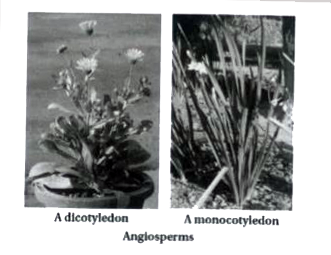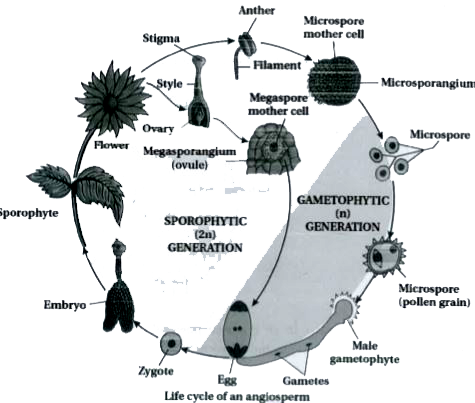Write a note on Angiosperms.
Text Solution
• In the Angiosperms or flowering plants the pollen grain and ovules are developed in specialised structures called flowers.
• Seeds are enclosed by fruit.
• The angiosperms are an exceptionally large group of plants occurring in wide range of habitats. They range in size from tiny, almost microscopic wolfia to tall trees of Eucalyptus (over 100 metres) grow in Australia.
• They provide us with food, fodder, fuel, medicines and several other commercially important products.
• Classification of Angiosperms: Angiosperms are classified in two classes :
(i) Dicotyledons and (ii) Monocotyledons.
• (i) The dicotyledons : There are two cotyledons in dicotyledons. Leaves possess reticulate venation and flowers are Tetramerous or pentamerous (Means there are four to five members in each flower).
• (ii) Monocotyledons : There is only one cotyledon in seed of monocotyledons leaves possess parallel venation and flowers are trimerous means there are three members in flower cycle]

• The male sex organ in a flower is stamen. Each stamen consists of a slender filament with anther at the tip. The anthers, following meiosis, produce pollen grains.
• Pistil consists of an ovary enclosing one to many ovules, style and stigma. In ovules female gametophyte developed by meiosis highly reduced female gametophytes are formed as embryo sacs. Each cell of an embryo sac is haploid.
• Each embryo sac has a three celled apparatus-one egg cell and two synergids, three antipodal cells and two polar nuclei. The polar nuclei eventually fuse to produce a diploid secondary nucleus.
• Double fertilisation in Angiosperms:
• Pollen grain after dispersal from the anthers, are carried by wind or various other agencies to the stigma of a pistil. This is termed as pollination.
• The pollen grains germinate on the stigma and the resulting pollen tubes grow through the tissues of stigma and style and reach the ovule. The pollen tubes enter the embryo-sac where two male gametes are discharged.
• One of the male gametes fuses with the egg cell to form a zygote (Syngamy). The other male gamete fuses with the diploid secondary nucleus to produce the triploid primary endosperm nucleus (PEN). Because of the involvement of two fusions, this event is termed as double fertilisation an event unique to angiosperms.
• The zygote develops into an embryo (with one or two cotyledons) and the PEN develops into endosperm which provides nourishment to the developing embryo. The synergids and antipodals degenerate after fertilization. During these events the ovules develop into seeds and ovaries develop into fruit.

|
Updated on:21/07/2023
Topper's Solved these Questions
- BOOK - KUMAR PRAKASHANCHAPTER - PLANT KINGDOMEXERCISE - SECTION - B (DIFFERENCE/SCIENTIFIC REASONS)7videos
PLANT KINGDOM
- BOOK - KUMAR PRAKASHANCHAPTER - PLANT KINGDOMEXERCISE - SECTION - C (DIFFERENCE/EXPLANATION - TERMS/IMPORTANCE/FULL NAME/CONTRIBUTION OF SCIENTISTS)18videos
PLANT KINGDOM
- BOOK - KUMAR PRAKASHANCHAPTER - PLANT GROWTH AND DEVELOPMENTEXERCISE - OBJECTIVE SECTION (FILL IN THE BLANKS)7videos
PLANT GROWTH AND DEVELOPMENT
- BOOK - KUMAR PRAKASHANCHAPTER - RESPIRATION IN PLANTSEXERCISE - Questions from Module (Question Paper)3videos
RESPIRATION IN PLANTS
Similar Questions
Write a note on liquation process.
View SolutionWrite a note on Arms control.
View SolutionWrite a note on different types of endosperms in angiosperms.
View SolutionWrite a short note on double fertilisation in angiosperm.
View SolutionWrite a note on the role of pollination in the growth and development in an angiosperm.
View Solution(a) Write a note on Hell-Volhard-Zelinsky (HVZ) reaction.
(b) Write a short note on Koch reaction.
(c) Write a short note on Arndt-Eistert reactionView SolutionWrite down four main characters of angiosperms.
View SolutionWrite a note on natural rubber.
View SolutionWrite a note on electrical hazards.
View SolutionDescribe the process of double fertilization in angiosperms and add a note on its significance.
View Solution

